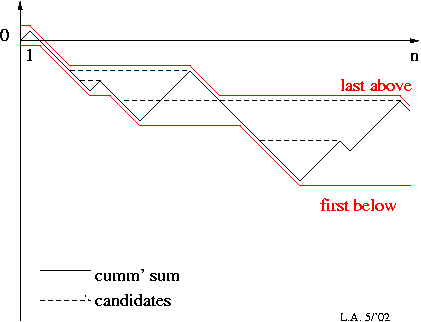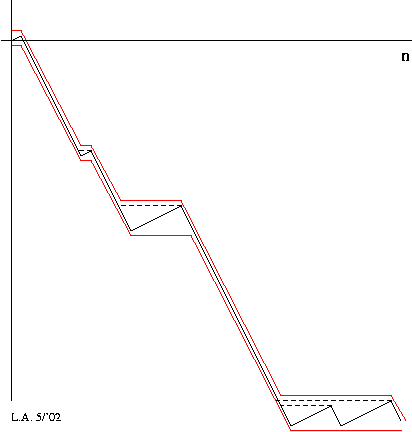Algorithms 1D L'B'I' rational general *in Java |
1. Rational Bias
Problem:
Given a data sequence, e.g. ACGTAGCAGATAGACAGGTTAGACAATAGAG,
and a "bias" criterion,
In the HTML-form below, the fraction is p/q where p and q are small integers which (for given p and q) yields a simple, special-case, linear-time algorithm (but the multiplier depends on p and q).
key: `choice' -- acceptable characters. `p' and `q' -- p/q is the required fraction of acceptable characters.
2. General Bias
Give elements of the sequence a +ve value for "good" and a -ve value for "bad". Compute the cumulative sums from the start of the sequence. The sum of a "good enough" interval is non-negative, i.e. the cumulative sum is flat or increasing across the interval:

e.g. required ratio = 1/2
| cum' sum: | (solid black) the cumulative sum |
|---|---|
| first below: | tracks the 1st point where the cum' sum falls to certain value |
| last above: | tracks the last point at which the cum' sum holds a certain value (can be computed in a reverse scan of cum' sum) |
| candidates: | (dashed) indicate some possible ``longest biased intervals'' |
- (All) Longest Biased Intervals:
- (I.e. find every biased interval that is not
strictly contained in any other biased interval.)
- If the required minimum fraction (bias) is `x', where 0<=x<=1, give "good" elements a weight of +(1-x) and "bad" elements a weight of -x.
(NB. x need not be rational.)- Step along `last-above' from top-left to bottom-right (thus R.H. end of interval always advances) while
- looking back at first-below.
- The longest biased interval of all will be discovered by this process.
- If the required minimum fraction (bias) is `x', where 0<=x<=1, give "good" elements a weight of +(1-x) and "bad" elements a weight of -x.

e.g. required ratio = 2/3 (good = +1/3, bad = -2/3)
The following HTML-form implements a general algorithm for biases that are not necessarily rational. Its time-complexity is almost always O(n), but can be O(n2) in the worst case for ``pathalogical'' sequences.
Note that some numbers, including some common rational numbers, cannot be represented exactly in floating-point. Therefore one might need to give `ratio' a (very, very,) very little ``slack''.
3. Notes
Using binary-search to search (track) the array of cumulative-sum minima would give an O(n.log(n))-time, O(n)-space algorithm.
So of course, one could run both algorithms
in parallel and take the result from the first to finish
(also halting the other one):
O(n)-time usually and
O(n.log(n))-time worst case
4. Reference
L. Allison,
Longest Biased Interval and Longest Non-Negative Sum Interval,
© 3/2002, 3/2003, 4/2003.
|